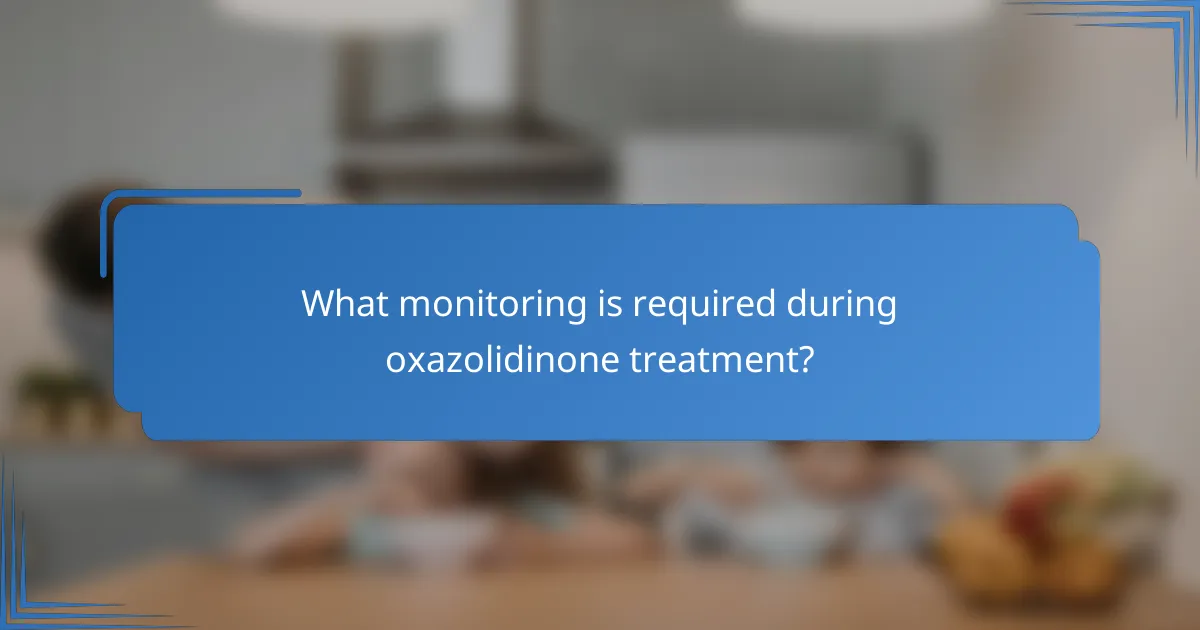Oxazolidinones, such as linezolid and tedizolid, are potent antibiotics used to treat pneumonia caused by resistant bacteria, functioning by inhibiting bacterial protein synthesis. However, these medications can interact with other drugs, necessitating careful management to ensure safety and effectiveness. Regular monitoring of blood counts, liver function, and potential side effects is essential during treatment to optimize patient outcomes.

What are the treatment options for pneumonia with oxazolidinones?
Oxazolidinones, particularly linezolid and tedizolid, are effective treatment options for pneumonia caused by resistant bacteria. These antibiotics work by inhibiting protein synthesis in bacteria, making them valuable in treating infections where other antibiotics may fail.
Linezolid effectiveness
Linezolid is particularly effective against gram-positive bacteria, including methicillin-resistant Staphylococcus aureus (MRSA). It is often used in cases of pneumonia where traditional treatments are ineffective, especially in hospital-acquired infections.
Clinical studies have shown that linezolid can significantly improve outcomes in patients with pneumonia caused by resistant organisms. However, monitoring for side effects, such as thrombocytopenia, is essential during treatment.
Tedizolid advantages
Tedizolid offers several advantages over linezolid, including a more favorable dosing schedule and potentially fewer side effects. It is administered once daily, which can enhance patient compliance.
Additionally, tedizolid has shown effectiveness against a broader range of pathogens, making it a suitable option for complicated pneumonia cases. Its lower potential for drug interactions also makes it a safer choice for patients on multiple medications.
Dosage recommendations
The typical dosage for linezolid in treating pneumonia is 600 mg every 12 hours for 10 to 14 days. Tedizolid is usually prescribed at 200 mg once daily for a similar duration.
It is crucial to adjust dosages in patients with renal impairment and to follow local guidelines for specific populations, such as pediatrics or the elderly, to ensure safety and efficacy.
Administration routes
Both linezolid and tedizolid can be administered orally or intravenously, providing flexibility based on the patient’s condition. Oral formulations are often preferred for outpatient treatment, while intravenous administration may be necessary for hospitalized patients.
Choosing the appropriate route depends on the severity of the pneumonia and the patient’s ability to tolerate oral medications. Continuous monitoring is recommended to assess treatment response and adjust administration routes as needed.

How do oxazolidinones interact with other medications?
Oxazolidinones can interact with various medications, affecting their efficacy and safety. Understanding these interactions is crucial for effective treatment and minimizing adverse effects.
Common drug interactions
Oxazolidinones, such as linezolid, can interact with several classes of medications. Notably, they may enhance the effects of certain antidepressants, particularly selective serotonin reuptake inhibitors (SSRIs), leading to increased risk of serotonin syndrome.
Other common interactions include those with monoamine oxidase inhibitors (MAOIs), which can cause hypertensive crises. Patients taking oxazolidinones should be monitored closely if they are on these medications.
Impact on serotonin levels
Oxazolidinones can significantly impact serotonin levels in the body. They inhibit monoamine oxidase, an enzyme responsible for breaking down serotonin, which can lead to elevated serotonin levels.
This elevation can result in symptoms of serotonin syndrome, such as agitation, confusion, and increased heart rate, especially when combined with other serotonergic drugs. It is essential for healthcare providers to assess a patient’s medication history to mitigate these risks.
Antibiotic resistance considerations
While oxazolidinones are effective against certain resistant bacterial strains, their use must be judicious to prevent further antibiotic resistance. Overuse or inappropriate prescribing can lead to the development of resistant organisms.
Healthcare professionals should consider the local prevalence of resistant bacteria when prescribing oxazolidinones and ensure that they are used only when necessary. Regular susceptibility testing can help guide appropriate use and preserve the effectiveness of these important antibiotics.

What monitoring is required during oxazolidinone treatment?
During oxazolidinone treatment, regular monitoring is essential to ensure patient safety and drug efficacy. Key areas of focus include blood counts, liver function, and monitoring for side effects.
Blood count monitoring
Blood count monitoring is crucial because oxazolidinones can cause bone marrow suppression, leading to thrombocytopenia or leukopenia. Regular complete blood counts (CBC) should be performed, typically every week for the first month and then biweekly thereafter, depending on the patient’s risk factors.
Patients with pre-existing conditions or those on other medications that affect blood counts may require more frequent monitoring. If significant drops in platelet or white blood cell counts are observed, dose adjustments or discontinuation may be necessary.
Liver function tests
Liver function tests (LFTs) are important as oxazolidinones can impact liver enzymes. Baseline LFTs should be obtained before starting treatment, followed by monitoring every 1-2 weeks during the initial phase of therapy.
Elevated liver enzymes may indicate hepatotoxicity, necessitating dose adjustments or switching to alternative therapies. Patients with existing liver conditions should be monitored more closely.
Signs of side effects
Monitoring for side effects is vital to ensure timely intervention. Common side effects of oxazolidinones include headache, nausea, and diarrhea, which should be reported to healthcare providers immediately.
Patients should be educated about serious side effects such as vision changes or signs of serotonin syndrome, especially if they are on other serotonergic medications. Regular follow-ups can help in identifying and managing these side effects effectively.

What are the side effects of oxazolidinones?
Oxazolidinones can cause a range of side effects, which may vary in severity. Common reactions include gastrointestinal issues and headache, while more serious side effects can involve blood disorders and neurological symptoms.
Common adverse reactions
Common adverse reactions to oxazolidinones typically include nausea, diarrhea, and headache. Patients may also experience dizziness or insomnia. These effects are usually mild and may resolve on their own as the body adjusts to the medication.
Monitoring for these common reactions is essential, especially during the initial phase of treatment. If symptoms persist or worsen, consulting a healthcare provider is advisable.
Serious side effects
Serious side effects of oxazolidinones can include thrombocytopenia, which is a decrease in platelet count, and peripheral neuropathy. These conditions may require immediate medical attention and discontinuation of the drug.
Healthcare providers often recommend regular blood tests to monitor for these serious side effects, particularly in patients on prolonged therapy. Awareness of symptoms such as unusual bruising, weakness, or tingling sensations can help in early detection and management.

What are the guidelines for prescribing oxazolidinones in Canada?
In Canada, oxazolidinones are prescribed primarily for the treatment of pneumonia caused by specific bacterial infections. The guidelines emphasize careful patient selection, monitoring for side effects, and awareness of potential drug interactions.
Health Canada recommendations
Health Canada recommends oxazolidinones, such as linezolid, for patients with pneumonia when other treatment options are unsuitable or ineffective. Prescribers should consider local resistance patterns and the patient’s clinical condition before initiating therapy.
Monitoring for adverse effects, particularly hematological changes and serotonin syndrome, is crucial during treatment. Regular blood tests may be necessary to ensure patient safety and treatment efficacy.
Patient eligibility criteria
Patients eligible for oxazolidinone therapy typically include those with confirmed or suspected pneumonia caused by resistant Gram-positive bacteria. Criteria also include a history of treatment failure with other antibiotics or specific contraindications to alternative therapies.
Before prescribing, assess the patient’s renal and hepatic function, as adjustments may be needed. Additionally, consider potential drug interactions, especially with serotonergic medications, to avoid complications.

How do oxazolidinones compare to other pneumonia treatments?
Oxazolidinones are effective antibiotics for treating pneumonia, particularly when caused by resistant bacteria. They differ from traditional treatments in their mechanism of action and are often reserved for specific cases due to potential side effects and interactions.
Drug interactions with oxazolidinones
Oxazolidinones can interact with several medications, leading to increased risks of side effects. Common interactions include those with serotonergic drugs, which can elevate the risk of serotonin syndrome, a potentially life-threatening condition. It’s crucial to review a patient’s medication list before prescribing oxazolidinones.
Additionally, oxazolidinones may affect the metabolism of certain drugs, such as anticoagulants. Monitoring INR levels in patients taking warfarin is advisable to prevent complications. Always consult a healthcare provider for a comprehensive medication review.
Monitoring during oxazolidinone treatment
Monitoring is essential during oxazolidinone treatment to identify any adverse effects early. Regular blood tests may be necessary to check for thrombocytopenia, a decrease in platelets, which can occur with prolonged use. Patients should be advised to report any unusual bruising or bleeding.
Furthermore, monitoring for signs of peripheral neuropathy is important, especially in patients receiving long-term therapy. Educating patients about potential symptoms can facilitate early intervention and improve treatment outcomes.
